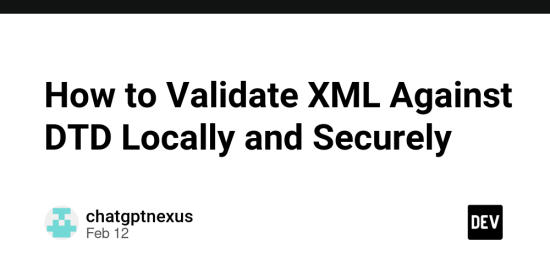Ensuring your XML files conform to their Document Type Definitions (DTD) without risking data exposure is crucial. Here are two effective methods for local, secure XML validation:
1. Command Line Tool: xmllint
xmllint, part of the libxml2 library, offers offline validation with no network risks.
Validation Steps:
# Basic syntax check
xmllint --noout your_file.xml
# DTD validation (XML must declare DOCTYPE)
xmllint --dtdvalid your_dtd.dtd --noout your_file.xml
Key Parameters:
-
--noout: Prevents output of XML content. -
--dtdvalid: Specifies the path to the external DTD file. -
--nonet: Forces disabling network connections, enhancing security.
Common Issues and Solutions:
-
DTD Not Linked Error
Add the DTD declaration in your XML’s header:
-
DTD Syntax Errors
Ensure your DTD file does not include a
declaration, only element/attribute definitions. -
Batch Validation Script
find ./xml_files -name "*.xml" -exec xmllint --dtdvalid schema.dtd --noout {} ;
2. VS Code XML Extension
The XML extension by Red Hat for VS Code provides real-time validation across Windows, Mac, and Linux.
Setup Process:
-
Install the Extension
Search for “XML” by Red Hat in VS Code’s extension marketplace and install.
-
Link DTD File
Add to
settings.json:
"xml.fileAssociations": [{
"pattern": "**/*.xml",
"systemId": "https://dev.to/path/to/your.dtd"
}]
-
XML Catalog Support
Createcatalog.xmlfor mapping public identifiers:
xmlns="urn:oasis:names:tc:entity:xmlns:xml:catalog">
publicId="-//Your//DTD" uri="your.dtd"/>
Feature Comparison:
| Feature | xmllint | VS Code XML Extension |
|---|---|---|
| Real-time Validation | ❌ Requires command execution | ✅ Automatic during typing |
| Error Localization | ❌ Line numbers in CLI | ✅ Visual markers in editor |
| Auto-completion | ❌ | ✅ Based on DTD |
| Batch Processing | ✅ Scriptable | ❌ Single file operations |
| Cross-platform | ✅ Linux/Mac/Windows | ✅ All platforms |
Recommendations for Choosing a Method
- Development & Debugging: Opt for the VS Code extension for real-time feedback and auto-completion.
-
CI/CD Pipelines: Use
xmllintfor scripting in automated workflows like Jenkins or GitHub Actions. -
Sensitive Data Validation: Both methods support offline operation, but
xmllintwith--nonetadds an extra layer of security.
References






